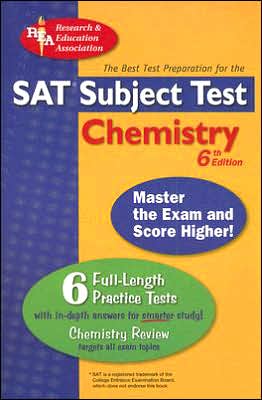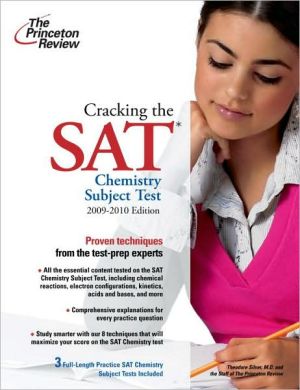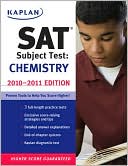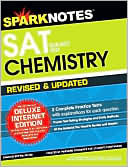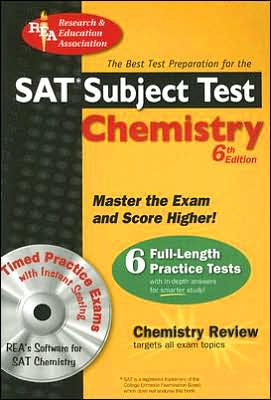SAT Subject Test: Chemistry (REA) -- The Best Test Prep for the SAT II: 6th Edition
Master the SAT Chemistry Subject Test and score higher. Our test experts show you the right way to prepare for this important college exam. REA's SAT Chemistry test prep covers all chemistry topics that appear on the actual exam including in-depth coverage of the laws of chemistry, properties of solids, gases and liquids, chemical reactions, and more. The book features 6 full-length practice SAT Chemistry exams. Each practice exam question is fully explained to help you better understand the...
Search in google:
Master the SAT Chemistry Subject Test and score higher. Our test experts show you the right way to prepare for this important college exam. REA's SAT Chemistry test prep covers all chemistry topics that appear on the actual exam including in-depth coverage of the laws of chemistry, properties of solids, gases and liquids, chemical reactions, and more. The book features 6 full-length practice SAT Chemistry exams. Each practice exam question is fully explained to help you better understand the subject material. Follow up your study with REA's proven test-taking strategies, drills and adaptable study schedule that get you ready for test day.DETAILS- Comprehensive review of every chemistry topic to appear on the SAT subject test- Flexible study schedule tailored to your needs- Packed with proven test tips, strategies and advice to help you master the test- 6 full-length practice SAT Chemistry Subject tests. Each test question is answered in complete detail with easy-to-follow, easy-to-grasp explanations.- The book's handy Periodic Table of Elements allows for quick answers on the elements appearing on the exam
\ About This Book This book provides you with an accurate and complete representation of the SAT Chemistry Subject Test. Inside you will find a complete course review designed to provide you with the information and strategies needed to do well on the exam, as well as six practice tests based on the actual exam. The practice tests contain every type of question that you can expect to appear on the SAT Chemistry Subject Test. Following each test you will find an answer key with detailed explanations designed to help you master the test material.\ About the Test Who Takes the Test and What Is It Used for?\ Students planning to attend college take the SAT Chemistry Subject Test for one of two reasons:\ (1) Because it is an admission requirement of the college or university to which they are applying,\ OR\ (2) To demonstrate proficiency in Chemistry.\ The SAT Chemistry test is designed for students who have taken a one-year introductory course in chemistry.\ Who Administers the Test?\ The SAT Chemistry Subject Test is developed by the College Board and administered by Educational Testing Service (ETS). The testdevelopment process involves the assistance of educators throughout the country, and is designed and implemented to ensure that the content and difficulty level of the test are appropriate.\ When Should the SAT II: Chemistry be Taken?\ If you are applying to a college that requires Subject Test scores as part of the admissions process, you should take the SAT Chemistry Subject Test by November or January of your senior year. If your scores are being used only for placement purposes, you may be able to take the test in the spring. Make sure to contact the colleges to which you are applying for more specific information.\ When and Where is the Test Given?\ The SAT Chemistry Subject Test is administered five times a year at many locations throughout the country, mostly high schools. The test is given in October, November, December, January, May, and June.\ To receive information on upcoming administrations of the exam, consult the publication Taking the SAT II: Subject Tests, which may be obtained from your guidance counselor or by contacting:\ College Board Admissions Testing Program P.O. Box 6200 Princeton, NJ 08541-6200 Phone: (609) 921-9000 Website: http://www.collegeboard.comIs there a Registration Fee?\ You must pay a registration fee to take the SAT Chemistry. Consult the College Board's Website (www.collegeboard.com) for information on the fee structure. Financial assistance may be granted in certain situations. To find out if you qualify and to register for assistance, contact your academic advisor.\ How to Use This Book\ What Do I Study First?\ Remember that the SAT Chemistry Subject Test is designed to test knowledge that has been acquired throughout your education. Therefore, the best way to prepare for the exam is to refresh yourself by thoroughly studying our review material and taking the sample tests provided in this book. They will familiarize you with the types of questions, directions, and format of the SAT Chemistry Subject Test.\ To begin your studies, read over the reviews and the suggestions for test-taking, take one of the practice tests to determine your area(s) of weakness, and then restudy the review material, focusing on your specific problem areas. The course review includes the information you need to know when taking the exam. Make sure to take the remaining practice tests to further test yourself and become familiar with the format of the SAT Chemistry Subject Test.\ When Should I Start Studying?\ It is never too early to start studying for the SAT Chemistry test. The earlier you begin, the more time you will have to sharpen your skills. Do not procrastinate! Cramming is not an effective way to study, since it does not allow you the time needed to learn the test material. The sooner you learn the format of the exam, the more comfortable you will be when you take it.\ Format of the SAT Chemistry Subject Test\ The SAT Chemistry test is a one-hour exam consisting of 85 multiple-choice questions.\ The first part of the exam consists of classification questions. This question type presents a list of statements or questions that you must match up with a group of choices lettered (A) through (E). Each choice may be used once, more than once, or not at all.\ The exam then shifts to relationship analysis questions which you will answer in a specially numbered section of your answer sheet. You will have to determine if each of two statements is true or false and if the second statement is a correct explanation of the first.\ The last section is composed strictly of multiple-choice questions with choices lettered (A) through (E).\ Material Tested\ The following chart summarizes the distribution of topics covered on the SAT Chemistry Subject Test.\ Topic Percentage Number of Questions Atomic / Molecular Structure 25 21\ States of Matter 15 13\ Reaction Types 14 12\ Stoichiometry 12 10\ Equilibrium & Reaction Times 7 6\ Thermodynamics 6 5\ Descriptive Chemistry 13 11\ Laboratory 8 7\ The questions on the SAT Chemistry test are also grouped into three larger categories according to how they test your understanding of the subject material.\ Category Definition ApproximatePercentage of Test Factual Recall Demonstrating a knowledge and understanding of important concepts and specific informarion. 20\ Application Taking a specific principle and applying it to a practical situation. 45\ Integration Inferring information and drawing conclusions from particular relationships. 35\ Scoring the SAT Chemistry subject test\ The SAT Chemistry test, like all other Subject Tests, is scored on a 200-800 scale.\ How Do I Score My Practice Test?\ Your exam is scored by crediting one point for each correct answer and deducting one-fourth of a point for each incorrect answer. There is no deduction for answers that are omitted. Use the worksheets below to calculate your raw score and to record your scores for the six practice tests. Once you've calculated your raw score, consult the conversiob table on page 9 to find your scaled score.\ Scoring Worksheet\ __________ - (_______ X 1/4) = __________\ number correct number incorrect(do not includeunanswered questions) Raw Score(round to nearest whole point)\ Raw Score Scaled Score Test 1\ Test 2\ Test 3\ Test 4\ Test 5\ Test 6\ Studying for the SAT Chemistry Test It is very important to choose the time and place for studying that works best for you. Some students may set aside a certain number of hours every morning to study, while others may choose to study at night before going to sleep. Other students may study during the day, while waiting on a line, or even while eating lunch. Only you can determine when and where your study time will be most effective. Be consistent and use your time wisely. Work out a study routine and stick to it!\ When you take the practice tests, try to make your testing conditions as much like the actual test as possible. Turn your television and radio off, and sit down at a quiet table free from distraction. Make sure to time yourself with a timer.\ As you complete each practice test, score your test and thoroughly review the explanations to the questions you answered incorrectly; however, do not review too much at any one time. Concentrate on one problem area at a time by reviewing the questions and explanations, and by studying our review until you are confident you completely understand the material.\ Keep track of your scores. By doing so, you will be able to gauge your progress and discover general weaknesses in particular sections. You should carefully study the reviews that cover your areas of difficulty, as this will build your skills in those areas.\ Test-Taking Tips Although you may be unfamiliar with standardized tests such as the SAT Chemistry Subject Test, there are many ways to acquaint yourself with this type of examination and help alleviate your test-taking anxieties. Listed below are ways to help you become accustomed to the SAT Chemistry Subject Test, some of which may apply to other standardized tests as well.\ Become comfortable with the format of the exam. When you are practicing to take the SAT Chemistry Subject Test, simulate the conditions under which you will be taking the actual test. Stay calm and pace yourself. After simulating the test only a couple of times, you will boost your chances of doing well, and you will be able to sit down for the actual exam with much more confidence.\ Know the directions and format for each section of the test. Familiarizing yourself with the directions and format of the exam will not only save you time, but will also ensure that you are familiar enough with the SAT Chemistry Subject Test to avoid nervousness (and the mistakes caused by being nervous).\ Do your scratchwork in the margins of the test booklet. You will not be given scrap paper during the exam, and you may not perform scratchwork on your answer sheet. Space is provided in your test booklet to do any necessary work or draw diagrams.\ If you are unsure of an answer, guess. However-if you do guess, guess wisely. Use the process of elimination by going through each answer to a question and ruling out as many of the answer choices as possible. By eliminating three answer choices, you give yourself a fifty-fifty chance of answering correctly since there will only be two choices left from which to make your guess.\ Mark your answers in the appropriate spaces on the answer sheet. Each numbered row will contain five ovals corresponding to each answer choice for that question. Fill in the circle that corresponds to your answer darkly, completely, and neatly. You can change your answer, but remember to completely erase your old answer. Any stray lines or unnecessary marks may cause the machine to score your answer incorrectly. When you have finished working on a section, you may want to go back and check to make sure your answers correspond to the correct questions. Marking one answer in the wrong space will throw off the rest of your test, whether it is graded by machine or by hand.\ You don't have to answer every question. You are not penalized if you do not answer every question. The only penalty you receive is if you answer a question incorrectly. Try to use the guessing strategy, but if you are truly stumped by a question, you do not have to answer it.\ Work quickly and steadily. You have a limited amount of time to work on each section, so you need to work quickly and steadily. Avoid focusing on one problem for too long. Taking the practice tests in this book will help you to learn how to budget your time.\ Before the Test Make sure you know where your test center is well in advance of your test day so you do not get lost on the day of the test. On the night before the test, gather together the materials you will need the next day:\ o Your admission ticket o Two forms of identification (e.g., driver's license, student identification card, or current alien registration card)\ o Two No. 2 pencils with erasers o Your calculator o Directions to the test center o A watch (if you wish) but not one that makes noise, as it may disturb other test-takers\ On the day of the test, you should wake up early (it is hoped after a decent night's rest) and have a good breakfast. Dress comfortably, so that you are not distracted by being too hot or too cold while taking the test. Also, plan to arrive at the test center early. This will allow you to collect your thoughts and relax before the test, and will also spare you the stress of being late. If you arrive after the test begins, you will not be admitted and you will not receive a refund.\ During the Test When you arrive at the test center, try to find a seat where you feel you will be comfortable. Follow all the rules and instructions given by the test supervisor. If you do not, you risk being dismissed from the test and having your scores canceled.\ Once all the test materials are passed out, the test instructor will give you directions for filling out your answer sheet. Fill this sheet out carefully since this information will appear on your score report.\ After the Test When you have completed the SATChemistry Subject Test, you may hand in your test materials and leave. Then, go home and relax!\ When Will I Receive My Score Report and What Will It Look Like?\ You should receive your score report about five weeks after you take the test. This report will include your scores, percentile ranks, and interpretive information.
CONTENTSAbout Research & Education Association Independent Study Schedule CHAPTER 1-About the Test About this Book About the Test How to Use this Book Format of the SAT Chemistry Subject Test Scoring the SAT Chemistry Subject Test Score Conversion Table Studying for the SAT Chemistry Subject Test Test-Taking Tips Chapter 2-Course Review Gases Gas Laws Gas Mixtures and Other Physical Properties of Gases Daltons Law of Partial Pressures Avogadros Law (The Mole Concept) Avogadros Hypothesis; Chemical Compounds and Formulas Mole Concept Molecular Weight and Formula Weight Equivalent Weight Chemical Composition Stoichiometry/Weight and Volume Calculations Balancing Chemical Equations Calculations Based on Chemical Equations Limiting-Reactant Calculations Solids Solids Phase Diagram Phase Equilibrium Properties of Liquids Density Colligative Properties of Solutions Raoults Law and Vapor Pressure Osmotic Pressure Solution Chemistry Concentration Units Equilibrium The Law of Mass Action Kinetics and Equilibrium Le Chateliers Principle and Chemical Equilibrium Acid-Base Equilibria Definitions of Acids and Bases Ionization of Water, pH Dissociation of Weak Electrolytes Dissociation of Polyprotic Acids Buffers Hydrolysis Thermodynamics I Bond Energies Some Commonly Used Terms in Thermodynamics The First Law of Thermodynamics Enthalpy Heats of Reaction Hesss Law of Heat Summation Standard States Heat of Vaporization and Heat of Fusion Thermodynamics II Entropy The Second Law of Thermodynamics Standard Entropies and Free Energies Electrochemistry Oxidation and Reduction Electrolytic Cells Non-Standard-State Cell Potentials Atomic Theory Atomic Weight Types of Bonds Periodic Trends Electronegativity Quantum Chemistry Basic Electron Charges Components of Atomic Structure The Wave Mechanical Model Subshells and Electron Configuration Double and Triple Bonds Organic Chemistry: Nomenclature and Structure Alkanes Alkenes Dienes Alkynes Alkyl Halides Cyclic Hydrocarbons Aromatic Hydrocarbons Aryl Halides Ethers and Epoxides Alcohols and Glycols Carboxylic Acids Carboxylic Acid Derivatives Esters Amides Arenes Aldehydes and Ketones Amines Phenols and Quinones Structural Isomerism Six Practice Tests Practice Test 1 Answer Key Detailed Explanations of Answers Practice Test 2 Answer Key Detailed Explanations of Answers Practice Test 3 Answer Key Detailed Explanations of Answers Practice Test 4 Answer Key Detailed Explanations of Answers Practice Test 5 Answer Key Detailed Explanations of Answers Practice Test 6 Answer Key Detailed Explanations of Answers Answer Sheets The Periodic Table
